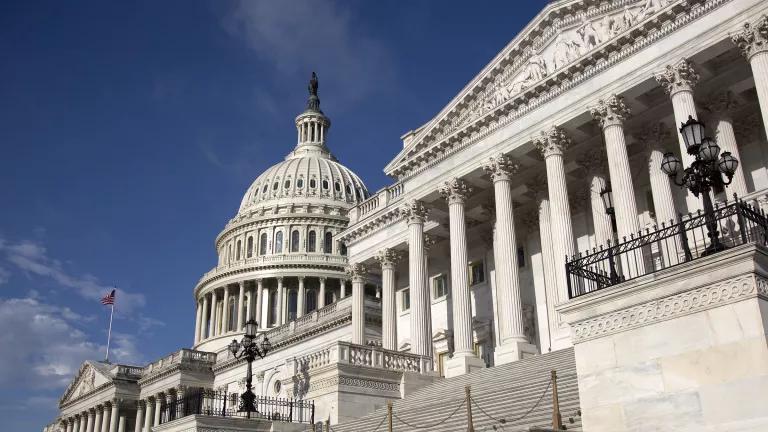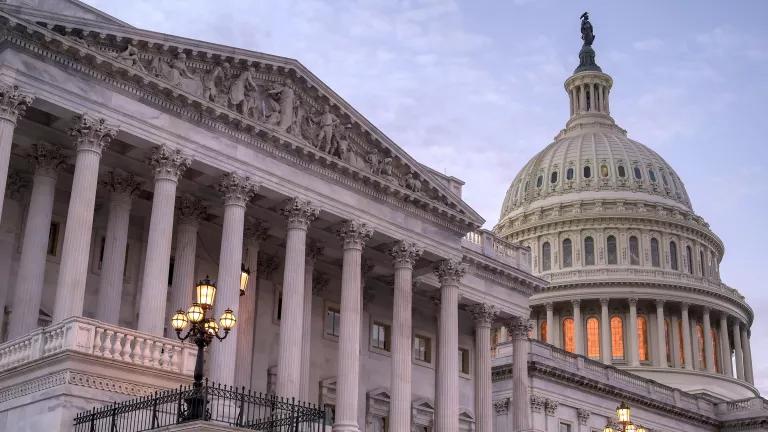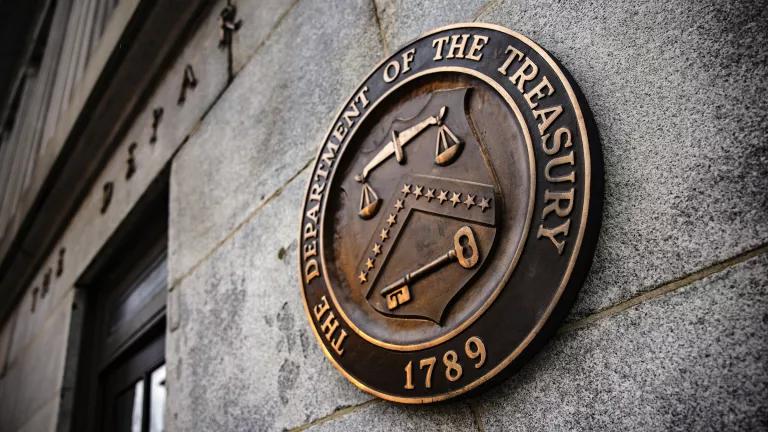Government Spending Bill Is Signed into Law: What You Need to Know
Getting to a bipartisan agreement in today’s hyper-divided Congress is a major feat—but there’s a lot of work to do yet.

President Biden stands with lawmakers after signing the Consolidated Appropriations Act for Fiscal Year 2022 in Washington, DC, on March 15, 2022.
Getting to a bipartisan agreement in today’s hyper-divided Congress is a major feat—but there’s a lot of work to do yet.
On Tuesday, President Biden signed into law a $1.5 trillion bill, referred to as an “omnibus” spending bill, that funds the government through September and also provides billions in assistance for Ukraine. The omnibus funding bill passed the Senate in a 68-to-31 vote last week, a day after it received strong bipartisan support in the House of Representatives.
Here’s why this is so important: The government has been funded under what is called a “continuing resolution,” meaning that Congress simply extended the previous fiscal year’s funding levels because it was unable to come to agreement on spending bills to cover the new year. Our nation’s agencies that were starved during the Trump administration and robbed of their ability to do key work are now starting to recover from the Trump-era funding levels that hobbled them.
In addition, having a signed law provides budgetary certainty for our federal agencies that have massive to-do lists as our nation tackles COVID-19, climate change, racial injustice, and urgent international issues. This also provides certainty for states and localities that rely on federal funding to carry out projects and programs in their jurisdictions.
Getting to a bipartisan agreement in today’s hyper-divided Congress is a major feat and represents an incredible effort by the appropriators to ensure the proper functioning of government, and we should all be grateful for that. However, even with all these goals met, we are still not where we need to be on funding in a host of critical areas.
Some Good News
This omnibus spending bill signals a return to science that the Trump era tried to deny. We are also seeing more support for communities in dire need. And departments and agencies will finally be funded at normal levels so they can focus on their essential work. Here are some highlights:
Departments and Agencies
- Departments and agencies across the board received badly needed yet modest increases, which will enable key departments to begin to return to normal by increasing staff and funding programs that safeguard our environment, health, and communities.
- The bill includes funding that will help with the implementation of the Bipartisan Infrastructure Law (Infrastructure Investment and Jobs Act)—including new programs that were not provided with money when the infrastructure bill passed—and provide much needed funding to the states to fix our failing infrastructure. However, exactly how much of the new funding in the omnibus will be available to hire staff and other resources to implement the Bipartisan Infrastructure Law is currently not clear. Some agencies, such as the Environmental Protection Agency (EPA), were devastated by budget and staffing losses that culminated during the Trump administration and have a lot of catching up to do to get back to full strength.
A Return to Science
- The bill contains $7.4 billion for the Department of Energy’s Office of Science to fund basic science research and secure our global leadership in energy innovation.
- Funding for the Department of Energy’s Office of Energy Efficiency & Renewable Energy increased ($3.2 billion) relative to fiscal year 2021. While this will boost key programs that focus on science-based solutions to problems like climate change, significantly greater increases are needed.
- The EPA’s core science and environmental programs budget was bumped up modestly to $3.6 billion, a $224 million increase.
Place-Based Investments
- The bill provides $30 million for a newly created Thriving Communities program for the Department of Transportation (DOT) and for the Department of Housing and Urban Development (HUD) to provide technical assistance, planning, and capacity-building to rural and urban underserved communities in need of improved transportation systems and to address historical inequities.
- The bill greenlights historic rail, transit, and bicycle/pedestrian investments from the Bipartisan Infrastructure Law, unleashing the DOT to make good on those promises. It also greenlights historic spending for programs that could go to either mostly new roads or a mix of clean transportation investments, including charging infrastructure and transit. Advocates must hold DOT accountable for implementing those provisions of the Infrastructure Investment and Jobs Act responsibly.
- Also included is the Weatherization Readiness Fund ($15 million), a new pilot program to address barriers to weatherization. For example: This program can support roof repairs to homes and apartment buildings that would otherwise make them ineligible for receiving existing weatherization assistance program (WAP) services. Hopefully, this program will be successful and expanded to a permanent program in coming years.
Some Bad News
This bill was a compromise, and unfortunately, too many key environmental policies were left by the wayside. Some disappointing lowlights:
Underfunding Climate Investments
- Fighting climate change was drastically underfunded as compared to other budget items in this bill.
- The bill dramatically underfunds international climate investments. We cannot claim that addressing the global climate crisis is a priority if we don’t prioritize it when we allocate our resources.
- These funding levels will make it very difficult for the United States to establish global leadership and credibility with the international community. The United States lags far behind its partners, including Germany and the United Kingdom, in international climate investments. (For more on international climate funding in the appropriations package, please see Jake Schmidt’s blog.)
Underfunding Wildlife
- The Fish & Wildlife Service and other agencies that protect wildlife and wildlands were significantly underfunded—some even below the president’s budget request—with little to no increases.
- These funding levels will make it extremely difficult to recover the nation’s 1,800 endangered species—not to mention the 400 species still waiting for protection.
- This is especially bad news given that we’re facing a biodiversity crisis, with scientists predicting that one million species stand to go extinct, many within decades. Just last year, the Fish & Wildlife Service announced it would remove 23 species from the endangered species list because they had gone extinct.
Safe Water
- Safe water generally received minimal increases or flat funding, and much more is needed to tackle the problem. For example, the funding bill fell short of the levels Congress authorized for the Drinking Water State Revolving Fund (DWSRF), which is the primary way that the federal government is funding lead service line replacements.
- The funding bill also provided less than 3 percent of the increases the president requested for small and disadvantaged water systems and grants to remove lead from school water.
- It also provided only a $1 million increase for lead service line removal in disadvantaged communities, which is far short of the $81 million the president requested.
“Legacy Riders”
- This bill contains “legacy riders” or types of restrictions on how funds can be used that contain harmful measures that undermine or harm the environment (such as clean air or endangered species).
- Many of the legacy riders in this bill represent special interests and harmful provisions that would likely not have become policy on their own merits but were instead included in this large package.
- For example, a legacy rider that blocks the sage grouse from being considered for protection under the Endangered Species Act was included despite the science that demonstrates the bird’s unsustainable decline.
What’s Next?
Notwithstanding the recent hard work of environmentally minded House and Senate Appropriations members, there is a lot of progress that Congress must still make to achieve the administration’s ambitious climate and environmental justice goals. First, Congress must return to the reconciliation bill now, to ensure that the essential environmental and climate provisions therein become law. The reconciliation bill represents our best chance for true, transformational change and to break the United States free from volatile oil and gas prices, transition to a clean energy economy, and solve the climate crisis. And second, Congress must get to work on the next budget and appropriations process, which will have to improve upon this one and include enough funding to truly achieve the goals set out by the administration.




